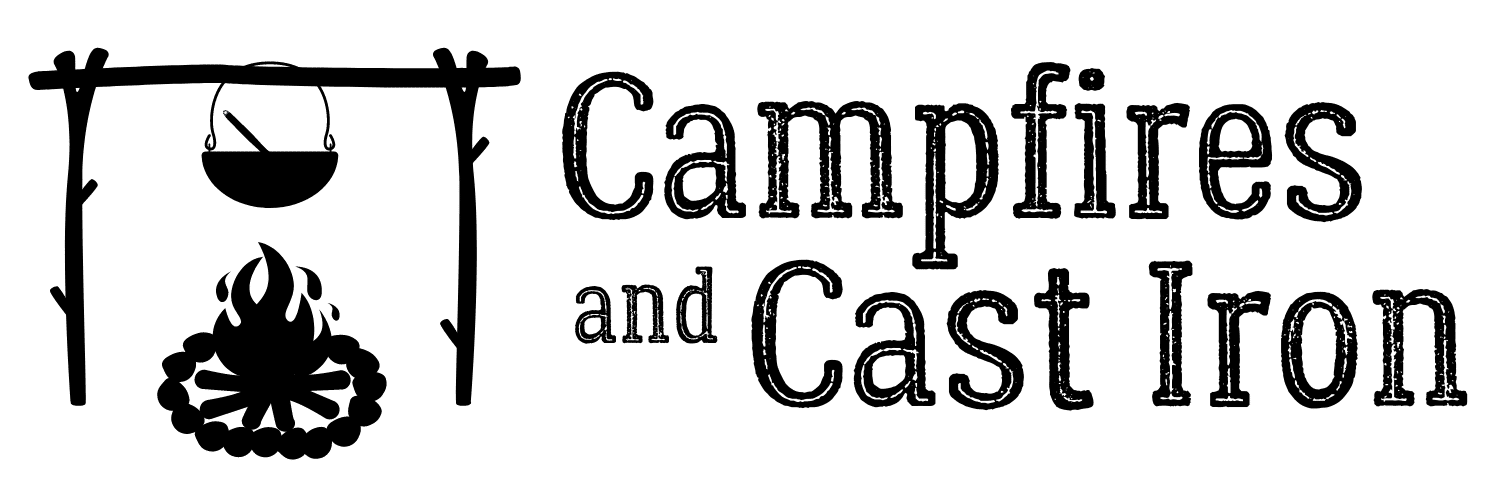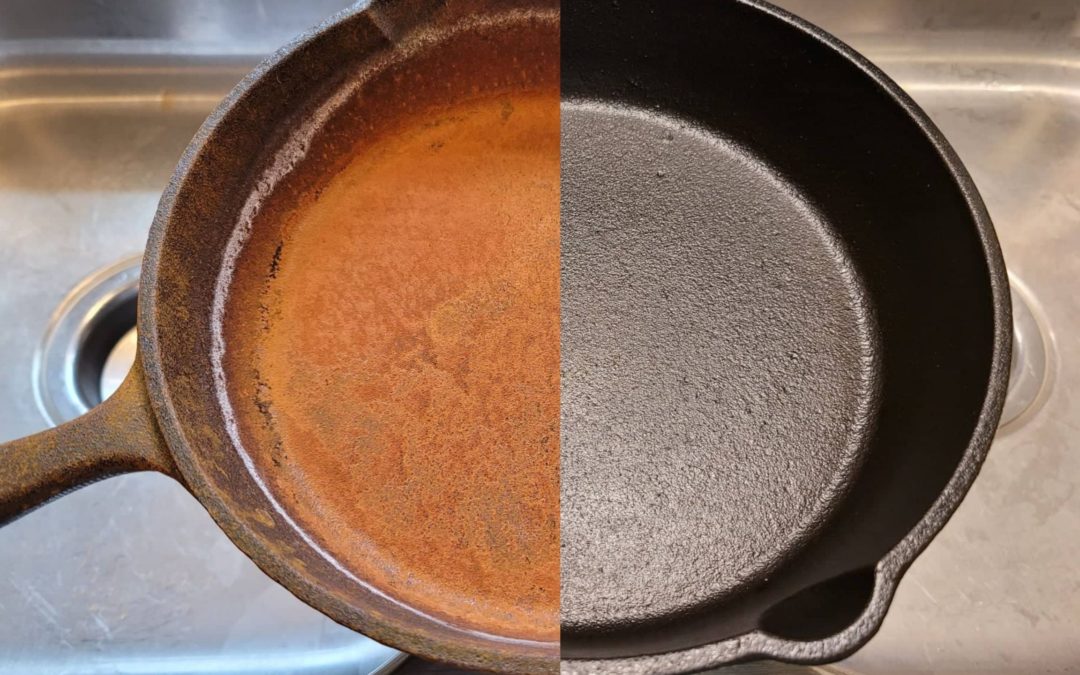Last updated on November 4th, 2022
If you’ve ever owned cast iron cookware, you’ve probably encountered rust at some point. Maybe you picked up a weathered, rusty cast iron pan at a yard sale or accidentally left your skillet soaking in the sink too long. Many people even report noticing rust on their cast iron cookware after the first couple of uses. Why does cast iron rust so quickly? What can be done to restore a rusty pan and prevent it from rusting in the future?
Rust forms quickly on cast iron pans when the iron is exposed to moisture and oxygen. Avoid soaking cast iron, dry it thoroughly, and store it in a dry location. Remove rust by soaking the pan in a 50/50 mixture of vinegar and water, then scrubbing it with a stiff brush. Rinse, dry, and re-season the pan.
In this article, we’ll take a deeper look at what causes cast iron cookware to rust and whether or not it is safe to cook with a rusty cast iron pan. I’ll also show you several ways to remove rust from cast iron and how to prevent your cookware from becoming rusty between uses.
What Causes A Cast Iron Skillet To Rust?
Cast iron, by nature, is prone to rust. When the iron comes into contact with moisture and oxygen, a chemical reaction called oxidation begins to occur. Oxidation of the iron produces iron oxide, the reddish, flaky substance otherwise known as rust.
This is one reason why seasoning is so important for cast iron. The seasoning layer acts as a shield for the iron, protecting it from oxidation and significantly reducing the potential for rust.
Here are the most likely reasons your cast iron cookware is rusting:
- Soaking cast iron: It’s okay to fill your cast iron pan with mild soap and water and let it sit for a minute or two to loosen difficult food residue. However, you don’t want to soak the pan for more than about five minutes, as this will allow moisture to seep deep into the pores of the cast iron and cause rust to form. Make sure to wash your pan quickly, then dry it thoroughly to eliminate lingering moisture and preserve the seasoning layer.
- Washing cast iron in the dishwasher: You should never put any type of cast iron cookware in the dishwasher. Dishwasher detergents are much more harsh than regular liquid dish soaps. They contain surfactants and enzymes designed to dissolve fats and oils, and will therefore strip away the seasoning layer on your cast iron. You’ll end up with a rusty, unevenly-surfaced pan that will take quite a bit of work to restore.
- Air drying cast iron: After washing your cast iron pan, dry it thoroughly with a towel. Don’t let your pan air-dry, or you’ll most certainly end up with rust. I always recommend towel-drying, then placing the pan on a stovetop burner over low-medium heat for about three minutes or in the oven at 200 degrees Fahrenheit for five to ten minutes to evaporate moisture deep within the pores of the iron.
- Storing cast iron in a damp environment: Beware of damp storage spaces, such as cabinets under the sink or beside the dishwasher. These areas are prone to higher levels of moisture and can cause cast iron cookware to rust. Also avoid storing cast iron outside, in garages, in damp basements, or in campers or RVs. Rusty cast iron is best prevented by storing pans in a low-humidity environment where air can circulate. It’s also helpful to place layers of paper towels between stacked pieces of cast iron cookware. Be sure to store dutch ovens, roasters, and lidded skillets with the lid off to allow for air circulation.
- Improper seasoning: When properly seasoned, cast iron pans are significantly more rust-resistant. The durable, smooth seasoning layer protects the raw iron underneath by preventing moisture from entering the microscopic pores of the iron and causing rust. This is very similar to how the paint on a vehicle protects the metal underneath from rusting. If your car’s paint has ever gotten scratched and you noticed a rust spot forming a few weeks later after being exposed to the rain or snow, you know what I mean.
Does Rust Ruin A Cast Iron Skillet?
Surface rust on a cast iron skillet is easy to remove. It doesn’t compromise the integrity of the iron and therefore won’t ruin the pan. A simple wash and scrub or a short vinegar bath will usually remove superficial rust quite easily. The pan can then be re-seasoned and used without issue.
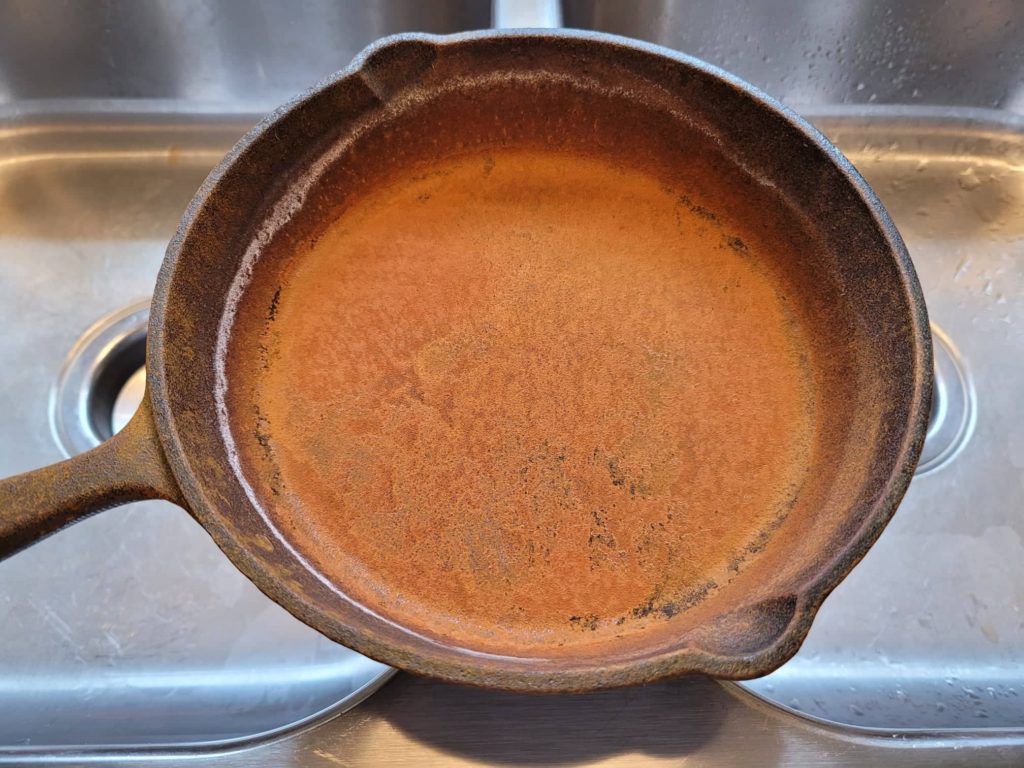
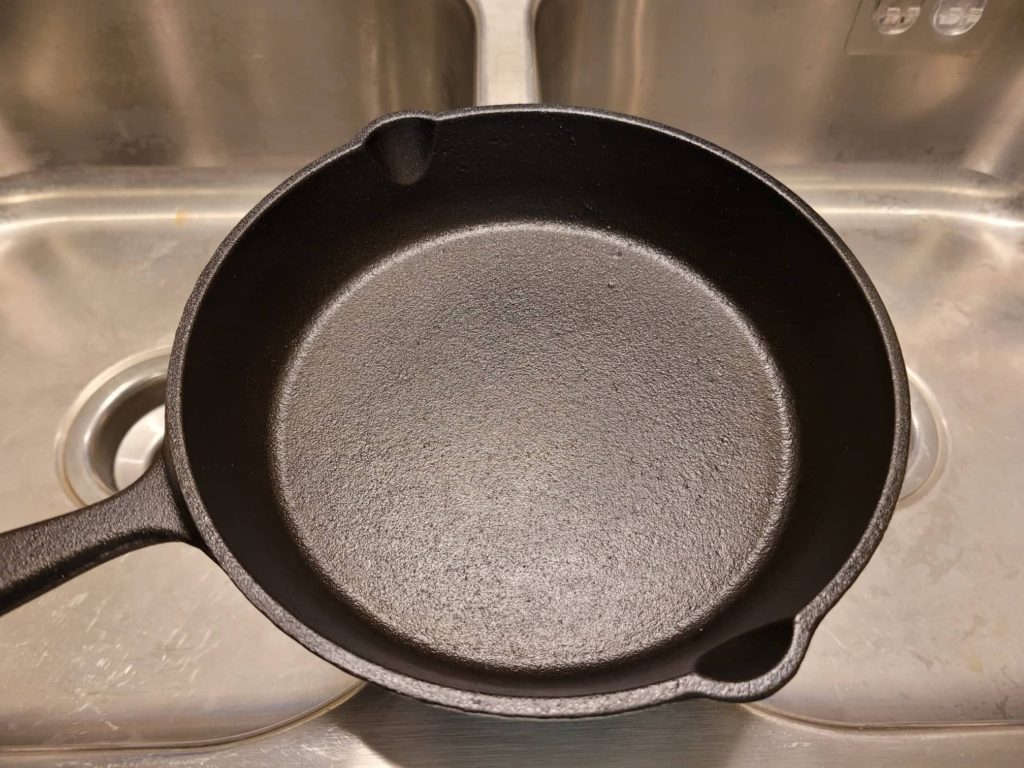
However, if left untreated, the oxidation reaction will continue to progress over time and will slowly eat away at the iron. This results in pitting corrosion, which looks like small divots or cavities in the metal. If left to continue, severe rust that has caused pitting and uneven surface thickness can permanently damage cast iron cookware.
An example of pitting can be seen in these photos. The unrestored skillet on the left has a notable area of rust present. After cleaning and restoration, the iron pitting is more visible in the top portion of the skillet. A skillet with a small area of mild pitting is still usable.
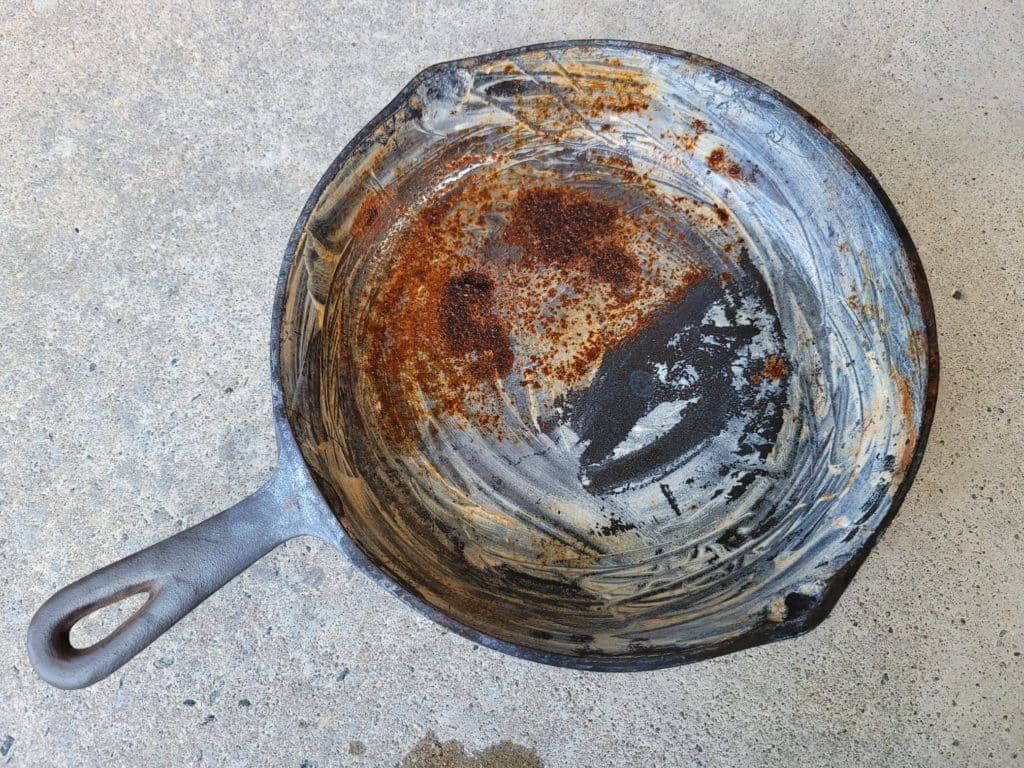
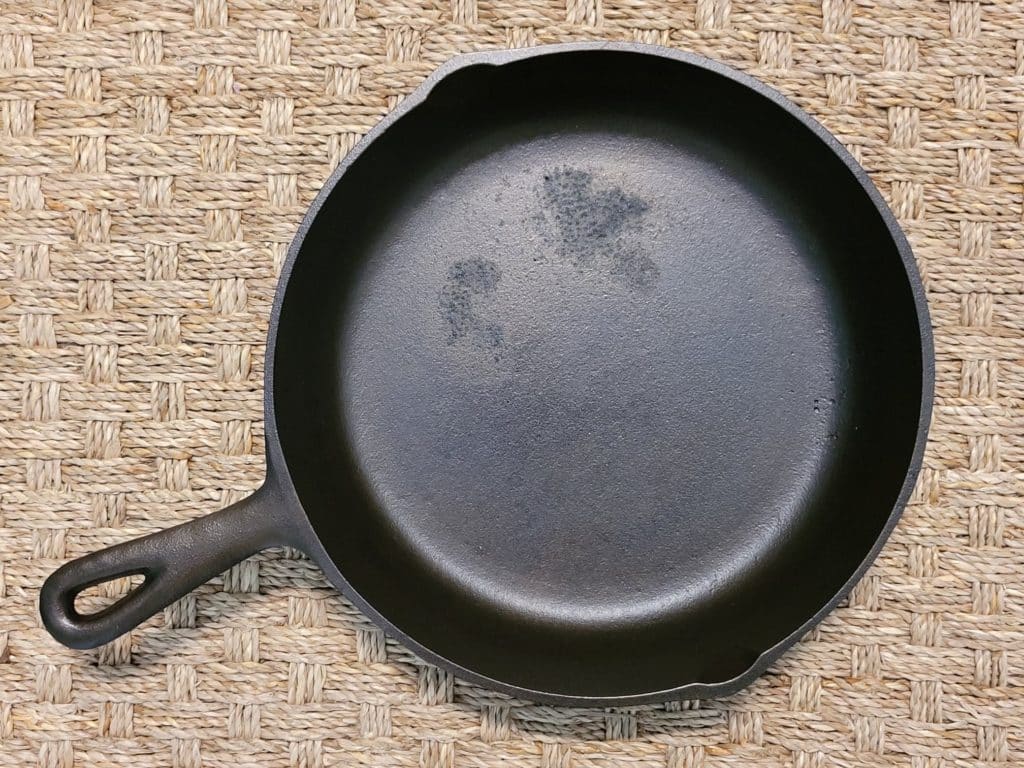
Despite having significant rust, it is usually possible to salvage a piece of cast iron cookware as long as it is not severely warped or cracked. Continue reading below for more information on this process.
Why Is My Cast Iron Pan Rusting After The First Use?
If you’ve recently gotten a new cast iron skillet and you’re frustrated to see some rust appearing after using it once or twice, don’t despair!
Most new cast iron pans come “pre-seasoned” from the factory. What this means is that one layer of seasoning has been applied to the pan at the time it was made. While it may be sufficient to start cooking with, the seasoning layer is pretty thin. This makes it susceptible to wearing away or chipping off within the first few uses, which can lead to rust formation.
To prevent this from happening, it’s best to season new cast iron pans, even pre-seasoned ones, two or three additional times prior to cooking with them. This will build an appropriately thick and durable seasoning layer that resists rust.
Is It Safe To Cook With A Rusty Cast Iron Pan?
Cooking with a cast iron pan that has a little bit of surface rust on it isn’t likely to hurt you. If your pan is seriously rusty or has visible rust flakes, you shouldn’t cook with it until the rust is removed and the pan is washed and re-seasoned. This will prevent iron and potential bacteria from contaminating your food.
Aside from affecting the flavor of your food, ingesting a very small amount of rust from cast iron cookware usually isn’t problematic. However, rust in your food can be dangerous in larger quantities. This is especially true if you have a certain health condition called Hemochromatosis, which is an inherited disease that causes the body to absorb and retain too much iron.
Continuing to cook with a rusted cast iron pan is also likely to make the rust worse over time. Therefore, you should always remove the rust, thoroughly wash and dry the pan, and re-season it two or three times to seal and protect the iron.
How To Clean And Restore A Rusty Cast Iron Skillet
When removing rust and restoring rusty cast iron cookware, you’ll always want to start with the least aggressive method first. If that doesn’t work well enough, move to the next method.
Methods To Remove Surface Rust:
Stiff Bristle Brush Or Sponge
First, use a stiff bristle brush, such as one made from nylon or natural plant fibers, and dish soap to wash the pan. Polymer scrubber sponges are also great for removing light rust from cast iron. Avoid soaking the pan longer than about five minutes to prevent the formation of additional rust.
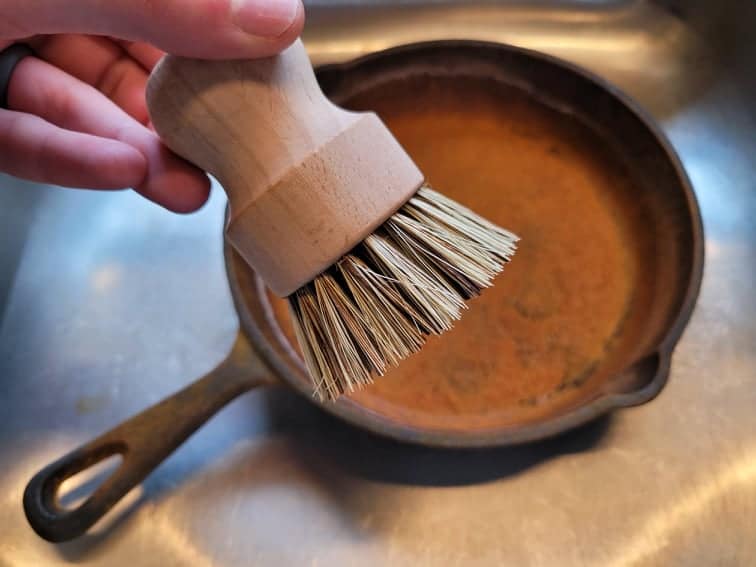
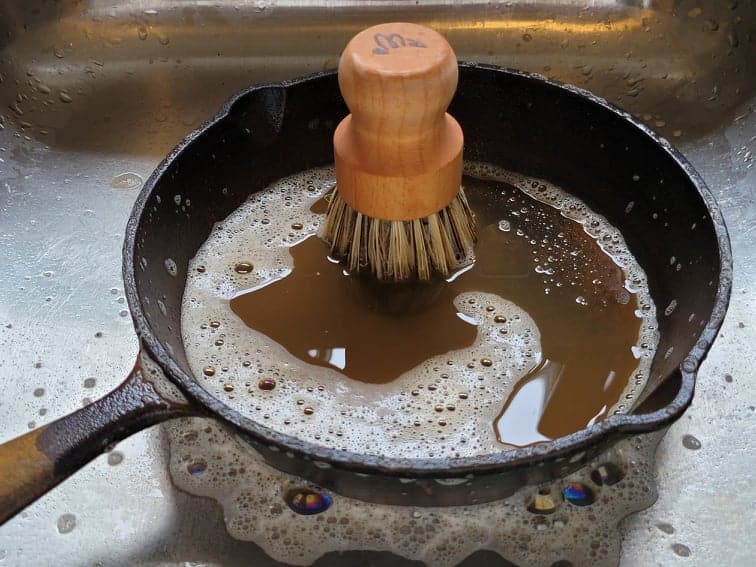
Chainmail Scrubber
A chainmail scrubber is a scouring device made of several small metal rings interlinked together to form a mesh. Some even have a silicone sponge inside, like this one.
Chainmail scrubbers are known for their ability to remove stuck or burnt-on food residue from cast iron without damaging the seasoning layer. They are also great for helping to remove rust. Many cast iron cookware manufacturing companies promote the use of chainmail scrubbers to routinely clean pans and help prepare your cast iron to accept new layers of seasoning.
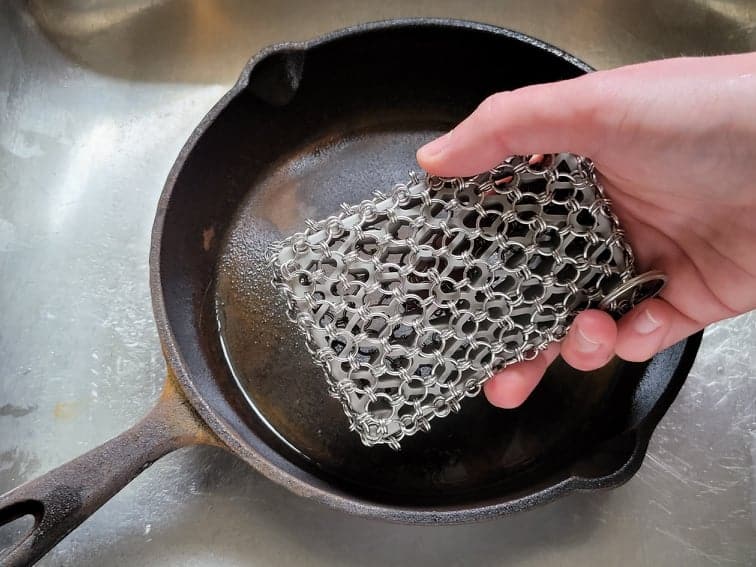
Lodge Rust Eraser
The Lodge Rust Eraser is a neat little tool that easily removes rust from cast iron. Made of rubber and silicon carbide, you use it just like an art eraser, but on your cast iron cookware. Note that the Rust Eraser is an abrasive cleaning tool and will remove some seasoning along with the rust. But that’s not a problem! Simply re-season your cast iron and you’ll be good to go.
I have used Lodge’s Rust Eraser on multiple occasions to remove rust from old skillets and dutch ovens. I’ll say, I have been quite impressed with how effective it is! I always keep one on hand for restoration projects and have purchased them as gifts for friends and family.
Here’s a little video of me using the Rust Eraser:
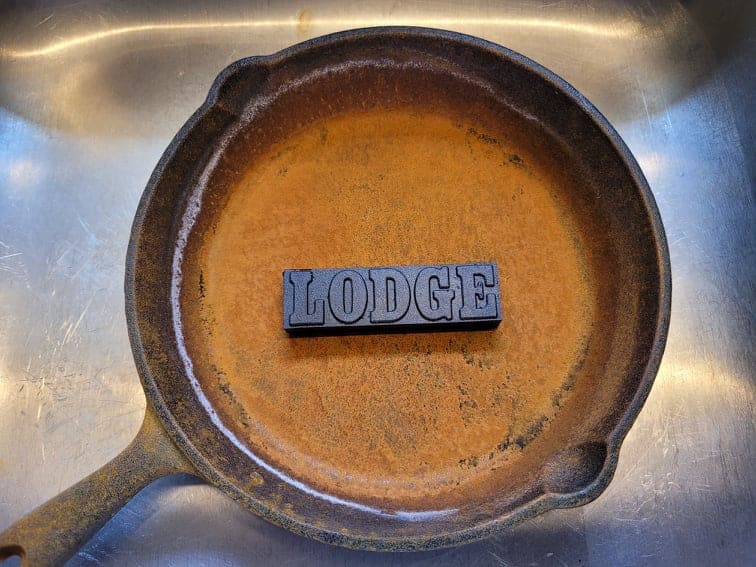
To see more about how well this tool really works, check out this impressive video of the Lodge Rust Eraser in action.
Steel Wool
Of all the cleaning options, steel wool is the most abrasive. It will remove both rust and the pan’s seasoning layer, often down to bare iron. After cleaning with steel wool, wash the pan with soap and water to remove metal particles and rust debris. Re-season the pan immediately after washing and drying it to prevent rust from re-forming on the unprotected metal.
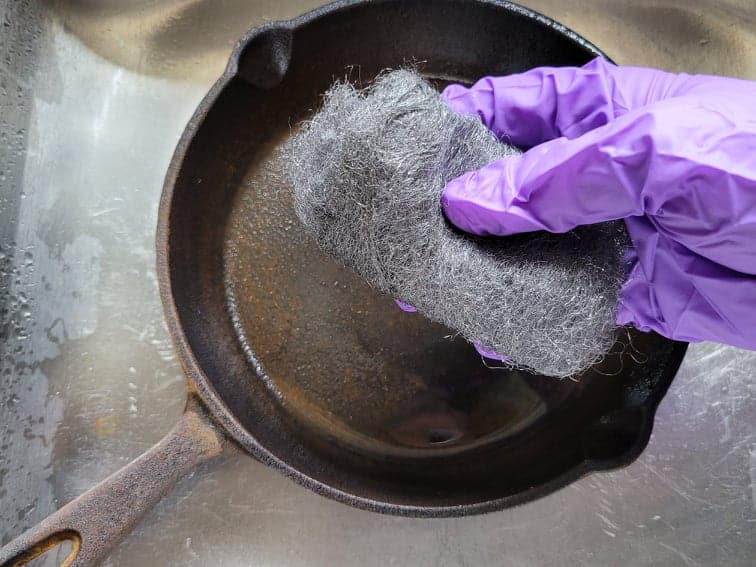
To Remove Deeper, More Severe Rust:
Vinegar Bath
A vinegar bath is a useful method for loosening difficult or widespread rust. If your pan is completely rusty and scrubbing it with plenty of elbow grease just isn’t cutting it, try this:
1. Fill the sink or a plastic tub that is large enough to fully submerge the cast iron pan in with a 50/50 mixture of distilled white vinegar and water.
2. Let the pan soak for about 30 minutes. Rust removal with a vinegar bath often requires two or three 30-minute rounds of soaking and scrubbing for best results. You’ll need to keep a close eye on the pan, though. After the vinegar has dissolved the rust, it will start dissolving the iron underneath. This can cause permanent damage to your cast iron pan. Always set a timer when your pan is in the vinegar bath to prevent this.
3. After soaking, immediately rinse the pan in cool water to neutralize the vinegar and stop the rust-dissolving reaction.
4. Scrub the pan with a stiff bristle brush or steel wool and dish soap. Rinse it well to remove rust particles and prepare the metal for re-seasoning.
Wash And Dry The Pan Thoroughly
After removing rust, wash your cast iron pan with dish soap and water. Dry the pan thoroughly with a towel and then on the stovetop burner over low-medium heat for 2-3 minutes. Then, apply a very light coating of oil over the entire pan to prevent flash rust from forming. Flash rust occurs when bare iron is exposed to moisture and oxygen. The protective coat of oil protects the pan from rust until it can be seasoned in the oven.
How To Re-Season Your Cast Iron Pan
After removing rust, washing, and drying your pan, you’ll need to re-season it. Follow these easy instructions to successfully season cast iron:
1. Pre-heat the pan in the oven at 200 degrees Fahrenheit for 10 minutes. This better prepares the iron to accept the coating of oil that will soon be transformed into a layer of seasoning. Carefully remove the pan from the oven. Apply a very light coat of oil to both the inside and outside of the pan with a lint-free cloth. A little bit goes a really long way! Use the cloth to wipe down the entire pan again to remove any excess oil. As an alternative to liquid oil, I use this cast iron seasoning wax and have been extremely happy with it.
2. Place the cast iron pan in the oven at the recommended temperature based on the type of oil you’re using. This is typically between 450 and 500 degrees Fahrenheit. (See this chart for recommended oil types and oven temperatures). Let the pan remain in the oven for one hour, then turn off the oven. Crack the oven door open a few inches. Let the pan gradually cool off until it is safe to handle.
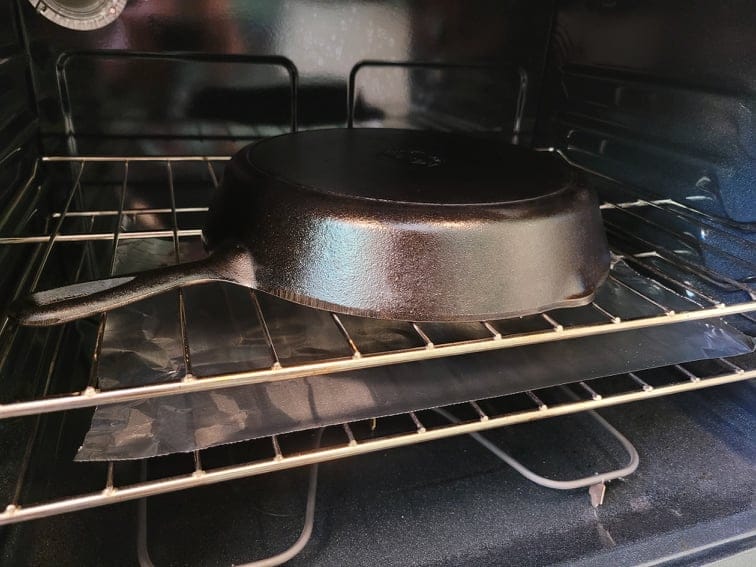
3. The key to successful, near-bulletproof cast iron seasoning is the application of multiple, thin layers of seasoning. Repeat the oiling and heating process two to three more times to build up a really strong, easy-release finish that resists rust.
Summary: How To Prevent Your Cast Iron Skillet From Rusting
To summarize, dry your cast iron pan thoroughly after every use and avoid letting it soak in water. Make sure your skillet is well-seasoned. A good way to tell if your cast iron is seasoned properly is to hold it at an angle and pour some water across the cooking surface. If the surface of the pan stays pretty wet, you should re-season it. If the water beads up and runs off quickly, you have a good seasoning layer. The videos below demonstrate what this should look like.
A Poorly Seasoned Skillet: Note how water remains spread across the pan’s surface.
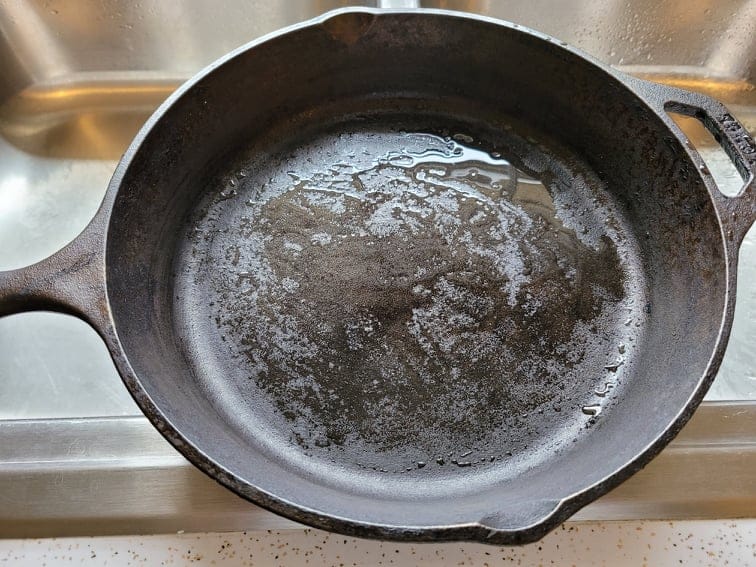
A Well-Seasoned Skillet: Note how water beads up and quickly runs off the pan’s surface.
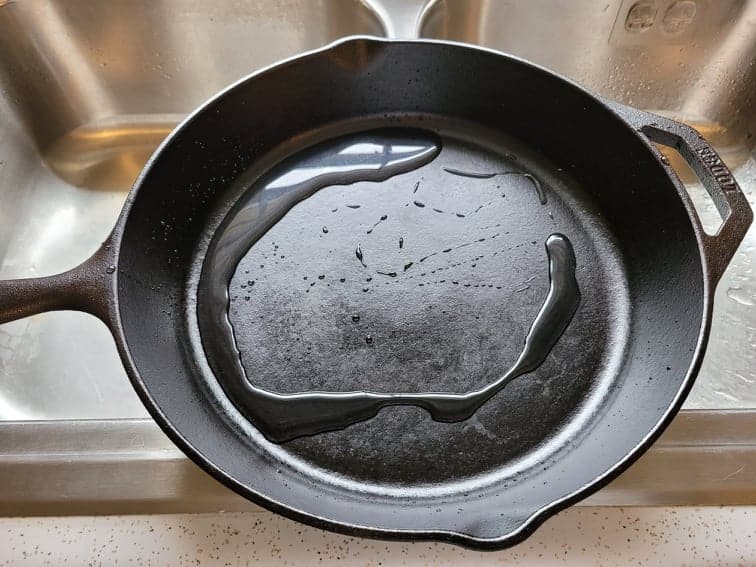
Always store your cast iron cookware in a clean, dry environment. Place a few paper towels between stacked pieces of cast iron to improve air circulation.
Lastly, if you happen to encounter any rusty cast iron pans, follow the steps outlined above to restore them to a good, useable condition.
Take care of your cast iron, and it will take care of you for years to come!
Want to see more incredible cast iron restoration before and after photos? Check out the gallery at the bottom of our Restoration Services page. You won’t believe some of the amazing transformations!
Recommended Items
These are the cast iron cleaning and restoration tools I use:
This post may contain affiliate links. This means if you click on a link and make a purchase, I will receive a small commission, at no cost to you, that makes it possible for me to keep the Campfires and Cast Iron site up and running. Please see our disclosure policy for details.
